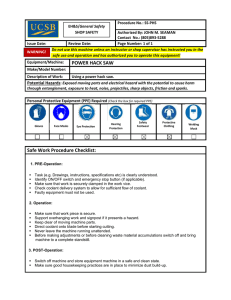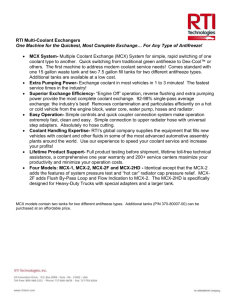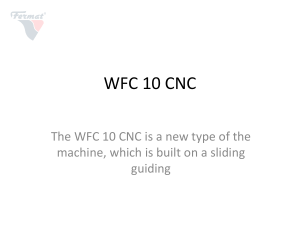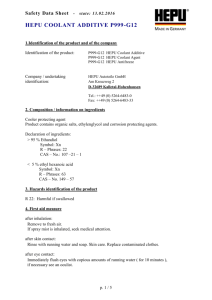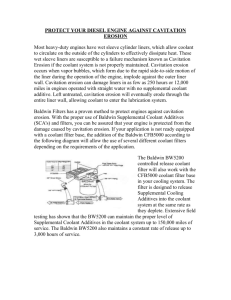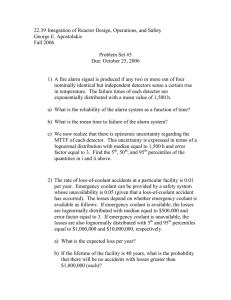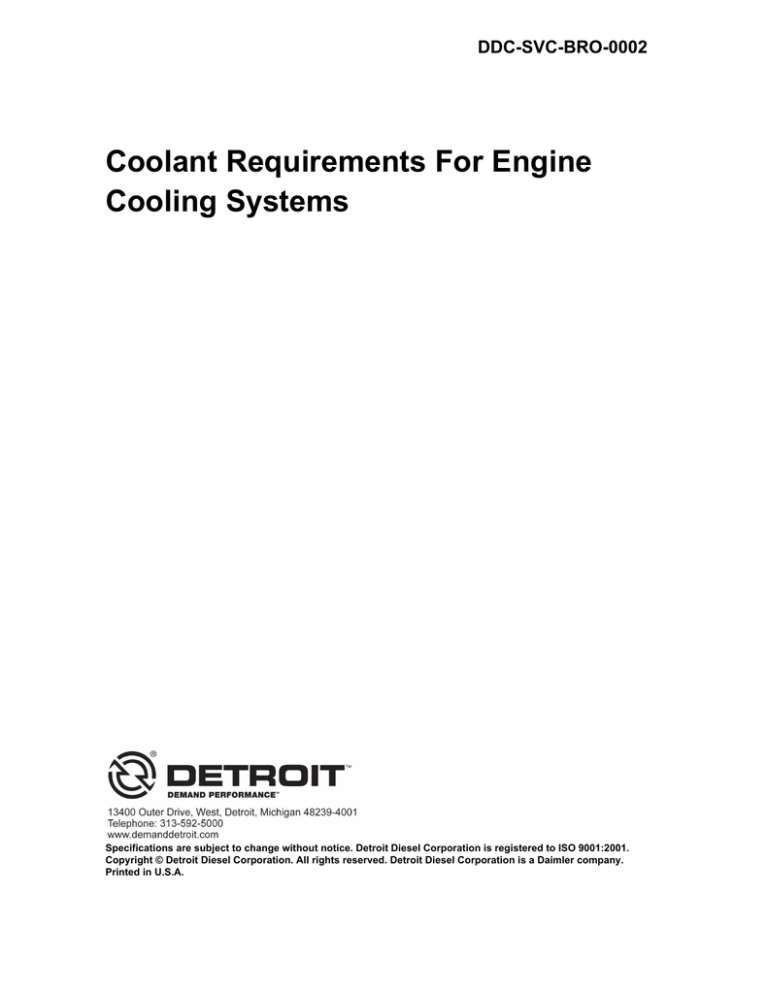
DDC-SVC-BRO-0002
Coolant Requirements For Engine
Cooling Systems
Specifications are subject to change without notice. Detroit Diesel Corporation is registered to ISO 9001:2001.
Copyright © Detroit Diesel Corporation. All rights reserved. Detroit Diesel Corporation is a Daimler company.
Printed in U.S.A.
Table of Contents
Table of Contents
1 Preface...................................................................................................................................................................................... 3
1.1 Preface............................................................................................................................................................................. 3
2 Introduction............................................................................................................................................................................. 4
2.1 Introduction..................................................................................................................................................................... 4
3 Coolant Fill Options................................................................................................................................................................ 5
3.1 Coolant Fill Options........................................................................................................................................................ 5
4 Coolants for Detroit™ Engines.............................................................................................................................................. 6
4.1 Coolants for Detroit™ Engines....................................................................................................................................... 6
4.2 Coolants NOT Permitted................................................................................................................................................. 6
4.3 Non-Formulated Additives NOT Permitted.................................................................................................................... 6
5 Maintenance............................................................................................................................................................................. 7
5.1 Maintenance.................................................................................................................................................................... 7
5.2 Topping Off Coolant....................................................................................................................................................... 7
5.3 Coolant Maintenance Intervals........................................................................................................................................ 7
5.4 Extended Life Coolant Additive Maintenance Procedures............................................................................................. 8
5.5 Standard Life Coolant Additive Maintenance Procedures.............................................................................................. 9
6 Appendix A - Definitions....................................................................................................................................................... 11
6.1 Appendix A - Definitions.............................................................................................................................................. 11
7 Appendix B - General Coolant Information....................................................................................................................... 12
7.1 Appendix B - General Coolant Information.................................................................................................................. 12
8 Appendix C - Detroit™ Cooling System Maintenance Products...................................................................................... 14
8.1 Appendix C - Detroit™ Cooling System Maintenance Products.................................................................................. 14
2
All information subject to change without notice.
Copyright © 2015 DETROIT DIESEL CORPORATION DDC-SVC-BRO-0002
Coolant Requirements For Engine Cooling Systems
1
Preface
1.1
Preface
Extended Life Coolants
Extended Life Coolant (ELC) contains Organic Acid Technology (OAT) which provides corrosion protection and inhibits
liner cavitation. These coolants require less maintenance over the useful life of the engine.
ELC antifreeze coolants are commercially available from Detroit™ (recommended) and other manufacturers as either
concentrated or pre-mixed formulations. Concentrated antifreeze coolants should be mixed at 50% (50% antifreeze/50%
water). All ELC's used must also meet Detroit 93K217 specification. Detroit™ requires that these types of coolants to be free
of nitrite and phosphate. Detroit™ has found that ELC's containing nitrite may lead to a breakdown of the coolant and
subsequent damage to the cooling system.
These types of coolants should not be mixed with Standard Life Coolants. If an ELC antifreeze coolant and SLC
antifreeze coolants are mixed, damage may not result, but the long-life advantages of the ELC antifreeze coolant will be lost.
In this event, the coolant should be re-inhibited with OAT inhibitors and confirmed by analysis or else it must be maintained
as an SLC antifreeze coolant.
SLC Antifreeze Coolants
Standard Life Coolant (SLC) contains inhibitor salts, including nitrites, to prevent liner cavitation. These coolants require
interval testing to maintain inhibitor concentration.
SLC antifreeze coolants are commercially available from Detroit™ (recommended) and other manufacturers as either
concentrated or as pre-mixed antifreeze. Concentrated antifreeze coolants should be mixed at 50% (50% antifreeze/50%
water). All fully formulated coolants used must also meet Detroit 93K217 specification.
NOTE:
Fully formulated antifreeze does not require a dosage of Supplemental Coolant Additive (SCA) at initial use.
All information subject to change without notice.
DDC-SVC-BRO-0002 Copyright © 2015 DETROIT DIESEL CORPORATION
3
2 Introduction
2
Introduction
2.1
Introduction
This publication is intended to specify the coolants, filters and maintenance intervals required for the diesel-fueled engines
manufactured and marketed by Detroit™.
Selection of the proper approved coolant and filter in conjunction with mandatory coolant and filter maintenance is required
to achieve optimal performance Detroit™ engines. Operating Detroit engines with unapproved coolants and filters may void
the manufacturer's warranty.
NOTE:
For off-highway engine coolant requirements, refer to MTU® Technical Publication, Fluids and Lubricants,
Specification, A001061/32E. This bulletin is available from authorized MTU Detroit™ distributors.
4
All information subject to change without notice.
Copyright © 2015 DETROIT DIESEL CORPORATION DDC-SVC-BRO-0002
Coolant Requirements For Engine Cooling Systems
3
3.1
Coolant Fill Options
Coolant Fill Options
The coolants recommended for use in Detroit™ engines are listed in Table "HDEP Coolant Fill Options". This publication
will give a complete explanation of their use.
NOTICE: Required specifications for water, Ethylene Glycol (EG), Propylene Glycol (PG), inhibitor packages, and
inhibitor concentration are included in the appendix of this publication. To avoid possible engine damage from
inadequate or over-concentrated coolant, this publication should be read thoroughly before replacing or toppingoff coolant.
Table 1.
HDEP Coolant Fill Options
Engine Series
Coolant Fill Options
Product
Ethylene Glycol based antifreeze coolant +
SLC corrosion inhibitors
Detroit Power Cool or refer to 93K217
list of approved coolants at
DDCSN-DDC.Freightliner.com
Propylene Glycol based antifreeze coolant +
SLC corrosion inhibitors
No Detroit™ product available. Refer to
93K217 list of approved coolants at
DDCSN-DDC.Freightliner.com
Ethylene Glycol based antifreeze coolant +
ELC inhibitors
Detroit Power Cool Plus or refer to
93K217 list of approved coolants at
DDCSN-DDC.Freightliner.com
Propylene Glycol based antifreeze coolant +
ELC inhibitors
No Detroit™ product available. Refer to
93K217 list of approved coolants at
DDCSN-DDC.Freightliner.com
DD13, DD15, DD16
Table 2.
Legacy Engine Coolant Fill Options
Engine Series
Series 50, Series 55,
Series 60, MBE900,
MBE4000
1Water-only
Coolant Fill Options
Product
Ethylene Glycol based antifreeze coolant +
SLC corrosion inhibitors
Detroit Power Cool or refer to 93K217
list of approved coolants at
DDCSN-DDC.Freightliner.com
Propylene Glycol based antifreeze coolant +
SLC corrosion inhibitors
No Detroit™ product available. Refer
to 93K217 list of approved coolants at
DDCSN-DDC.Freightliner.com
Water based coolant + SLC corrosion
inhibitors 1
Deionized Water + Detroit Genuine
Coolant 3000
Ethylene Glycol based antifreeze coolant +
ELC inhibitors
Detroit Power Cool Plus or refer to
93K217 list of approved coolants at
DDCSN-DDC.Freightliner.com
Propylene Glycol based antifreeze coolant +
ELC inhibitors
No Detroit™ product available. Refer
to 93K217 list of approved coolants at
DDCSN-DDC.Freightliner.com
Water based coolant + ELC inhibitors 1
Deionized Water + Detroit Genuine
Coolant Plus 6000
coolant systems offer no freeze protection and should not be used where ambient temperatures can fall to 0°C (32°F).
Additional approved coolant products can be found on the Detroit 93K217 list at DDCSN-DDC Freightliner.com (https://
ddcsn-ddc.freightliner.com/cps/rde/xchg/ddcsn/).
All information subject to change without notice.
DDC-SVC-BRO-0002 Copyright © 2015 DETROIT DIESEL CORPORATION
5
4 Coolants for Detroit™ Engines
4
Coolants for Detroit™ Engines
4.1
Coolants for Detroit™ Engines
The intent of this bulletin is to provide the requirements, directions, and information required to ensure cooling system
protection for Detroit™ engines. These recommendations are general rules and reflect years of experience, technology
research, and product development. Specific concerns not covered by this publication should be addressed to your local
Detroit™ representative. The coolant used in Detroit™ engines must meet Detroit 93K217 Specifications with the following
basic requirements:
•
•
•
•
•
•
Provide an adequate heat transfer medium.
Protect against cavitation damage to both cylinder liners and water pumps.
Provide a corrosion/erosion-resistant environment.
Prevent formation of scale or sludge deposits.
Be compatible with cooling system hose and seal materials.
Provide adequate freeze protection.
The rest of this section will describe the requirements for the proper usage of the water, antifreeze, and corrosion inhibitors. It
will also describe the coolants and additives that are not recommended by Detroit™ and have been proven harmful to
Detroit™ engines.
4.2
Coolants NOT Permitted
The following coolants are not to be used in Detroit™ engines:
• Automotive/Passenger car-type coolants must not be used in Detroit™ engines because they offer no liner pitting
protection. Also, these types of coolants generally contain high levels of phosphates and silicates.
• Methyl alcohol-based antifreeze must not be used in Detroit™ engines because of its effects on the nonmetallic
components of the cooling system and its low boiling point.
• Methoxy propanol-based antifreeze must not be used in Detroit™ engines because it is not compatible with fluorocarbon
elastomer seals found in the cooling system.
• Glycol-based coolants formulated for Heating/Ventilation/Air Conditioning (HVAC) must not be used in Detroit™
engines. These coolants generally contain high levels of phosphates, which will form deposits on hot internal engine
surfaces, reduce heat transfer, and cause water pump seal leaks.
• Waterless-type coolants must not be used.
• Nitrite Organic Acid Technology (NOAT)must not be used in Detroit™ engines because with poor maintenance
components become more vulnerable.
4.3
Non-Formulated Additives NOT Permitted
The following additives should not be used in Detroit™ engines:
• Soluble Oils: Soluble oil additives are not approved for use in Detroit™ engine cooling systems. A small amount of oil
adversely affects heat transfer. For example, a 1.25% concentration of soluble oil increases the fire deck temperature 6%.
A 2.50% concentration increases the fire deck temperature 15%. The use of soluble oil additives may result in engine
overheating and/or failure.
• Chromates: Chromate additives are not approved for use in Detroit™ engine cooling systems. Chromate additives can
form chromium hydroxide, commonly called “green slime.” This, in turn, can result in engine damage due to poor heat
transfer. Cooling systems operated with a chromate-inhibited coolant must be chemically cleaned with Detroit™ Genuine
Coolant Twin Pack cooling system cleaner/conditioner (or equivalent sulfamic acid/sodium carbonate cleaner) and
flushed.
• Phosphate Inhibitors: Phosphate has tendency to form deposits on surfaces transferring high heat which ultimately affect
cooling capabilities. Phosphate deposits on water pump seals will result in coolant leakage across seal faces.
6
All information subject to change without notice.
Copyright © 2015 DETROIT DIESEL CORPORATION DDC-SVC-BRO-0002
Coolant Requirements For Engine Cooling Systems
5
Maintenance
5.1
Maintenance
This section describes procedures needed to maintain the proper coolant level and concentration.
5.2
Topping Off Coolant
The coolant level should be checked daily and at each service interval. If topping off is necessary, add coolant which is
identical to the initial–fill coolant. ELCs should be topped-off with a coolant of the same formulation; SLCs should also be
topped-off with a coolant of the same formulation.
5.3
Coolant Maintenance Intervals
Required Service Intervals
Table 3.
Extended Life Coolant:
Service Application
Engine Series
Series 40, 50, 60
MBE4000, MBE900
DD13, DD15, DD16
Long Haul 1
Every 160,000 km
(100,000 miles) or 1 year
4
Short Haul 2
Severe 3
Action Required
Every 112,000 km (70,000
miles) or 1 year 4
Every 80,000 km (50,000
miles) or 1 year 4
Refer to section
"Extended Life Coolant
Additive Maintenance
Procedures"
1. Long Haul (over-the-road transport) service applies to vehicles that annually travel more than 96,000 km (60,000 miles) and average
greater than 6 miles per gallon with minimal city stop-and-go operation.
2. Short Haul service applies to vehicles that annually travel up to 48,000-96,000 km (30,000-60,000 miles) and average between 5.1 and
5.9 miles per gallon.
3. Severe service applies to vehicles that annually travel up to 48,000 km (30,000 miles) and average less than 5 miles per gallon or that
operate under severe conditions. Severe service also applies to RV applications. Service applies to vehicles that annually travel up to
48,000 km (30,000 miles) or that operate under severe conditions. Only one of these conditions needs be met to categorize an application
as Severe Service.
4. Whichever comes first
All information subject to change without notice.
DDC-SVC-BRO-0002 Copyright © 2015 DETROIT DIESEL CORPORATION
7
5 Maintenance
Table 4.
Standard Life Coolant:
Service Application
Long Haul 1
Short Haul 2
Severe 3
Series 40, 50, 60
Every 48,000 km (30,000
miles) or 1 year 4
Every 32,000 km (20,000
miles) or 500h, or 6
months 4
Every 24,000 km (15,000
miles) or 300h, or 3
months 4
MBE4000, MBE900
Every 48,000 km (30,000
miles) or 1 year 4
Every 24,000 km (15,000
miles) or 500h, or 6
months 4
Every 16,000 km (10,000
miles) or 300h, or 3
months 4
DD13, DD15, DD16
Every 80,000 km (50,000
miles) or 1 year 4
Every 56,000 km (35,000
miles) or 895h, or 1 year 4
Every 40,000 km (25,000
miles) or 640h, or 6
months 4
Engine Series
Action Required
Refer to section "Standard
Life Coolant Additive
Maintenance Procedures"
1. Long Haul (over-the-road transport) service applies to vehicles that annually travel more than 96,000 km (60,000 miles) and average
greater than 6 miles per gallon with minimal city stop-and-go operation.
2. Short Haul service applies to vehicles that annually travel up to 48,000 to 96,000 km (30,000 to 60,000 miles) and average between 5.1
and 5.9 miles per gallon.
3. Severe service applies to vehicles that annually travel up to 48,000 km (30,000 miles) and average less than 5 miles per gallon or that
operate under severe conditions. Severe service also applies to RV applications. Service applies to vehicles that annually travel up to
48,000 km (30,000 miles) or that operate under severe conditions. Only one of these conditions needs be met to categorize an application
as Severe Service.
4. Whichever comes first.
Table 5.
Coolant Drain interval:
Engine Series
ELC
SLC
965,606 km (600,000 miles), 4 years or
engine overhaul
482,803 km (300,000 miles) or 2 years
Series 60, 50, 40
MBE4000, MBE900
DD13, DD15, DD16
5.4
Extended Life Coolant Additive Maintenance Procedures
The concentration of ELC corrosion inhibitors will gradually deplete, at a much slower rate than SLC corrosion inhibitors,
during normal engine operation. Corrosion inhibitor limits are established by the coolant manufacturer. Therefore Detroit™
recommends following the manufacturer’s recommendations as to minimum and maximum limits.
Freeze Point Check
To best measure the quality of anti-freeze coolant, a check of the freeze point (glycol concentration), by refractometer, should
be performed at each service interval to ensure anti-freeze levels are within specification. Detroit™ requires a freeze point of
-34°F (+/-10°F) to guarantee optimal engine protection. The exception would be certain regions that require a freeze point of
-60°F to protect against colder climates.
Laboratory Testing
Laboratory testing is the best practice for determining ELC coolant quality and will provide vital information regarding the
engine performance. A factory coolant analysis program is available through authorized Detroit™ service outlets. To verify
coolant acceptability, submit a sample for coolant analysis according to Table "Extended Life Coolant".
However, a laboratory meeting ISO 17025 requirements may be used in place of the Detroit™ Genuine Parts Program
laboratory.
8
All information subject to change without notice.
Copyright © 2015 DETROIT DIESEL CORPORATION DDC-SVC-BRO-0002
Coolant Requirements For Engine Cooling Systems
OAT Detection Strips
OAT Detection Strips that monitor the organic acid levels can be used to test the concentration of corrosion inhibitors in the
anti-freeze coolant. Detroit™ recommends consultation with your coolant manufacturer's technical representative for proper
application.
ELC Enhancers/Extenders
ELC enhancers/extenders can be used to extend the life of the coolant. These products should be added to your anti-freeze
coolant when corrosion inhibitors fall below manufacturer's recommendations. Detroit™ recommends consultation with your
coolant manufacturer's technical representative for proper application.
Drain, Flush, and Refill Procedure (See Appendix C for Product Part number)
When coolant has reached the end of life, it is recommended to properly clean your cooling system of any scale, deposits or
any other contaminants that may reduce the efficiency of the heat transfer. The coolant must be drained completely including
the block, radiator, and HVAC system. Next, flush the system with fresh, clean water. Replace drain fittings. Mix required
amount of Penray 2010 cleaner in a 5-gallon pail of water and pour into radiator inlet. Fill system completely with clean
water. Re-circulate cleaning solution by idling engine for 2 hours after top hose is hot. Temperature should be 88° to 95°C
(190 to 203ºF) to allow the thermostat to open.
Drain cleaning solution from the system. The radiator, block and HVAC system must both be drained. Flush with clean
water (through the radiator inlet) for 3 to 5 minutes. Replace drain fittings. Mix required Penray 2011 in a 5-gallon pail and
pour into radiator inlet (1 pound per 4 gallons cooling system capacity). Fill system completely with clean water. Re-circulate
the Penray 2011 conditioning solution by idling engine for 15 minutes after the top hose is hot (thermostat opens if it wasn’t
removed). Drain the Penray 2011 solution from the system. The radiator, block and HVAC system must both be drained.
Flush with clean water for 3-5 minutes. Keep flushing as long as water looks “rusty” or “turbid.” Replace drain fittings.
Recharge cooling system with the appropriate ratio of clean water and the proper antifreeze for your application.
5.5
Standard Life Coolant Additive Maintenance Procedures
The concentrations of SLC inhibitors will gradually deplete during normal engine operation. SCAs replenish the protection
for cooling system components and must be added to the cooling system on an as needed basis. Below are test procedures
that will assist in determining the inhibitor concentration.
5.5.1
Coolant Test Procedure
3-Way Test Strips
Nitrite concentration is an indication of the overall coolant inhibitor concentration in SLC formulations. These coolants must
be tested for nitrite concentration at the regular intervals as listed in Table "Standard Life Coolant". Detroit™ Genuine Fluid
Analysis 3-Way Test Strips (or equivalent) are recommended. Use these test strips to measure nitrite and glycol
concentrations. Cavitation/corrosion protection is indicated on the strip by the level of nitrite concentration. Freeze/boil-over
protection is determined by glycol concentration.
Laboratory Testing
As an alternative to the test strips, a factory coolant analysis program is available through authorized Detroit™ service
outlets. To verify coolant acceptability, submit a sample for coolant analysis according to Table "Standard Life Coolant".
Drain, Flush, and Refill Procedure (See Appendix C for Product Part Number)
When coolant has reached the end of life, it is recommended to properly clean your cooling system of any scale, deposits or
any other contaminants that may reduce the efficiency of the heat transfer. The coolant must be drained completely including
the block, radiator, and HVAC system. Next, flush the system with fresh, clean water. Replace drain fittings. Mix required
amount of Penray 2010 cleaner in a 5-gallon pail of water and pour into radiator inlet. Fill system completely with clean
water. Re-circulate cleaning solution by idling engine for 2 hours after top hose is hot. Temperature should be 88° to 95°C
(190 to 203ºF) to allow the thermostat to open.
All information subject to change without notice.
DDC-SVC-BRO-0002 Copyright © 2015 DETROIT DIESEL CORPORATION
9
5 Maintenance
Drain cleaning solution from the system. The radiator, block and HVAC system must both be drained. Flush with clean
water (through the radiator inlet) for 3 to 5 minutes. Replace drain fittings. Mix required Penray 2011 in a 5-gallon pail and
pour into radiator inlet (1 pound per 4 gallons cooling system capacity). Fill system completely with clean water. Re-circulate
the Penray 2011 conditioning solution by idling engine for 15 minutes after the top hose is hot (thermostat opens if it wasn’t
removed). Drain the Penray 2011 solution from the system. The radiator, block and HVAC system must both be drained.
Flush with clean water for 3-5 minutes. Keep flushing as long as water looks “rusty” or “turbid.” Replace drain fittings.
Recharge cooling system with the appropriate ratio of clean water and the proper antifreeze for your application.
5.5.2
Supplemental Coolant Additives (SCA)
Supplemental Coolant Additive (SCA) Solutions- for Ethylene or Propylene Glycol-based Antifreeze
Coolants
The coolant must be maintained with the proper concentration of corrosion inhibitors. As the concentration of inhibitors
deplete, additional SCA must be added to the coolant as indicated by a nitrite concentration of 900 PPM, or less. If the nitrite
concentration is greater than 900 PPM, do not add additional SCA. If the nitrite concentration is above 3200 PPM, the system
is over-inhibited. The system should be partially drained and filled with a 50/50 mix of water and EG or PG.
Supplemental Coolant Additive (SCA) Solutions - for Water-based Coolants (Legacy Engines Only)
In warm climates where freeze protection is not required, water only with corrosion inhibitors is approved for use. Wateronly systems need to be treated with the proper dosage of corrosion inhibitors. Detroit™ approved conventional SCA or OAT
corrosion inhibitors must be added to the water to provide required corrosion and cavitation erosion protection.
Need-Release Coolant Filters (FOR STANDARD LIFE COOLANT ONLY 1)
Need-Release coolant filters are available for Series 50, Series 60 and pre-2016 DD series engines. Membranes in the filters
release SCAs before the coolant approaches a corrosive condition, protecting the engine from corrosion. The need-release
elements release the SCA charge as needed, as opposed to the maintenance SCA elements, which instantaneously release the
SCA charge. Need-release coolant filter elements should be replaced after one year or 160,000 km (100,000 miles), or 3,000
operating hours, whichever comes first.
1. Need-Release filters are not to be used with ELC type coolants. Such use will cause serious damage to the engine.
10
All information subject to change without notice.
Copyright © 2015 DETROIT DIESEL CORPORATION DDC-SVC-BRO-0002
Coolant Requirements For Engine Cooling Systems
6
6.1
Appendix A - Definitions
Appendix A - Definitions
Antifreeze:
A substance that is added to the water in a vehicle’s cooling system that lowers the freeze point to prevent freezing. The two
most common antifreezes are ethylene glycol (EG) and propylene glycol (PG).
Coolant:
A fluid that transfers heat from the engine by circulation.
Extended Life Coolant (ELC): AKA - Long-Life Coolant or Organic Acid Technology:
These types of coolants have been formulated to extend the service interval of the coolant. Example of ELC is Power Cool
Plus.
Fully Formulated:
Antifreeze that contains all the necessary inhibitors to protect a diesel engine and does not, therefore, require a pre-charge of
Supplemental Coolant Additive before its first use.
Initial-Fill:
The coolant that is used in a new or rebuilt engine, or used any time the cooling system is emptied and then refilled with new
coolant.
Standard Life Coolant (SLC): AKA - Fully-Formulated or Conventional Coolant:
These types of coolants use supplemental coolant additives (SCA) to protect against corrosion or mechanical wear. Example
of SLC is Power Cool.
Supplemental Coolant Additive:
An additive used in a preventive maintenance program to prevent corrosion, cavitation, and the formation of deposits.
All information subject to change without notice.
DDC-SVC-BRO-0002 Copyright © 2015 DETROIT DIESEL CORPORATION
11
7 Appendix B - General Coolant Information
7
7.1
Appendix B - General Coolant Information
Appendix B - General Coolant Information
SLC Antifreeze Coolants
These products are available as Fully Formulated and Phosphate-Free. They are commercially available from Detroit™
(recommended) and other manufacturers as either concentrated antifreeze or as pre-mixed antifreeze. The pre-mixed
antifreeze is ready to use, while the concentrated coolant must be mixed with water prior to use. All fully formulated coolants
used must also meet Detroit 93K217 specification.
NOTE: Fully formulated antifreeze does not require a dosage of Supplemental Coolant Additive (SCA) at initial
use.
ELC Antifreeze Coolants
EG and PG based antifreeze coolants contain Organic Acid Technology (OAT). These coolants require less maintenance over
the useful life of the engine.
ELC antifreeze coolants are available as either concentrated or pre-mixed formulations. Concentrated antifreeze coolants
should be mixed at 50% (50% antifreeze/50% water). These types of coolants should not be mixed with SLCs. If an ELC
antifreeze coolant and SLC antifreeze coolants are mixed, damage may not result, but the long-life advantages of the ELC
antifreeze coolant will be lost. In this event, the coolant should be re-inhibited with OAT inhibitors and confirmed by
analysis or else it must be maintained as an SLC antifreeze coolant.
Water-Only Coolants (Series 50, 55 and 60 only)
In warm climates where freeze protection is not required, water only with corrosion inhibitors is approved for use. Wateronly systems need to be treated with the proper dosage of corrosion inhibitors. Detroit™-approved SCA or ELC corrosion
inhibitors must be added to the water to provide required corrosion and cavitation erosion protection.
Mixing Ethylene Glycol or Propylene Glycol Antifreeze and Water
It is highly recommended to use a pre-mixed 50/50 antifreeze coolant. However, if a concentrated Ethylene Glycol or
Propylene Glycol antifreeze is purchased, mix the antifreeze with water meeting the required quality standards and fill the
cooling system. See water requirement below for quality standards. If a pre-diluted coolant is purchased, simply fill the
cooling system.
For best overall performance, a coolant consisting of 50% concentration of antifreeze (50% antifreeze, 50% water) is
recommended. An antifreeze concentration of over 60% (60% antifreeze, 40% water) is not recommended due to poor heat
transfer, reduced freeze protection, and possible silicate dropout. An antifreeze concentration below 40% (40% antifreeze,
60% water) offers too little freeze and/or corrosion protection and is not recommended.
WATER REQUIREMENTS
Distilled or de-ionized water, which eliminates the adverse effects of minerals in tap water, is preferred. High levels of
dissolved chlorides, sulfates, magnesium, and calcium in some tap water causes scale deposits, sludge deposits and/or
corrosion. These deposits have been shown to result in water pump failures and poor heat transfer, resulting in overheating. If
tap water is used, the mineral content in the water must be below the maximum concentration listed in the table below.
12
All information subject to change without notice.
Copyright © 2015 DETROIT DIESEL CORPORATION DDC-SVC-BRO-0002
Coolant Requirements For Engine Cooling Systems
Table 6.
Maximum Mineral Concentration in Water
Minerals
Maximum Concentration
Parts per Million
Grains per Gallon
Chlorides
40
2.5
Sulfates
100
5.8
Total Dissolved Solids
340
20
Magnesium + Calcium Content
170
10
Figure 1. Procedure To Evaluate The Quality Of Water
Recycled Antifreeze
Antifreeze coolant made with ethylene or propylene glycol recycled by reverse osmosis, distillation, and ion exchange and
properly re-inhibited to meet ASTM D6471 or D6472 requirements has been demonstrated to provide service equivalent to
virgin antifreeze. Recycled antifreeze coolants of these types are preferred. However, suppliers of these recycled glycols must
provide evidence the product is free of contaminates listed below:
•
•
•
•
•
•
•
•
•
•
•
•
•
•
Acetates
Acetone
Ammonia
Boron
Ethanol
Formates
Glycolates
Ketones
Nitrate
Nitrite
Phenols
Phosphorus
Silicon
Toluene
Other recycled coolants, especially coolants recycled through filtration processes, are not recommended.
All information subject to change without notice.
DDC-SVC-BRO-0002 Copyright © 2015 DETROIT DIESEL CORPORATION
13
8 Appendix C - Detroit™ Cooling System Maintenance Products
8
Appendix C - Detroit™ Cooling System Maintenance Products
8.1
Appendix C - Detroit™ Cooling System Maintenance Products
Table 7.
Detroit™ Extended Life Coolant (Ethylene Glycol-based)
Coolant Type
Concentrate
Pre-Diluted (50:50)
Part Number
Description
OWI 23539616
One Gallon Jug - 4 Per Case (Canada)
OWI 23519397
One Gallon Jug- 6 Per Case
OWI 23519394
55-Gallon Drum
OWI 2359617
One Gallon Jug - 4 Per Case (Canada)
OWI 23519396
One Gallon Jug - 6 Per Case
OWI 23519398
55-Gallon Drum
OWI 2359084
275-Gallon Tote (Canada)
Table 8.
Detroit Genuine Coolant Plus Extender (for use with Detroit Genuine Coolant Plus)
Coolant Type
Part Number
Description
IEG Detroit™ Genuine Coolant; Series 50
and Series 60
OWI 23519400
One Quart Bottle - 6 Per Case
Table 9.
Detroit™ Standard Life Coolant (Ethylene Glycol-based)
Coolant Type
Concentrate
Pre-Diluted (50:50)
Part Number
Description
OWI 23539622
One Gallon Jug - 4 Per Case (Canada)
OWI 23512138
One Gallon Jug - 6 Per Case
OWI 23512139
55-Gallon Drum
OWI 23513503
Bulk Delivery - 1000 Gallon min.
OWI 23539623
One Gallon Jug - 4 Per Case (Canada)
OWI 23528203
One Gallon Jug - 6 Per Case
OWI 23518918
55-Gallon Drum
OWI 23538603
275-Gallon Tote
Table 10.
Detroit™ Genuine Coolant 2000 Supplemental Coolant Additives (SCA)
Coolant Type
IEG Detroit™ Genuine Coolant
14
Part Number
Description
PIC 23507858
Pint Bottle - 12 Per Case
PIC 23507860
5-Gallon Pail
PIC 23507861
55-Gallon Drum
All information subject to change without notice.
Copyright © 2015 DETROIT DIESEL CORPORATION DDC-SVC-BRO-0002
Coolant Requirements For Engine Cooling Systems
Table 11.
Detroit™ Genuine Coolant 3000 SCAs
Coolant Type
IEG Detroit™ Genuine Coolant
Part Number
Description
PIC 23507854
Pint Bottle - 12 Per Case
PIC 23507855
Half Gallon Jugs - 6 Per Case
PIC 23507856
5-Gallon Pail
PIC 23507857
55-Gallon Drum
Table 12.
Detroit Genuine Coolant 3000 SCA Filters (Series 50 and Series 60 Engines Only)
Coolant Type
IEG Detroit™ Genuine Coolant
Part Number
Description
23507545
4 Ounce (1 Pint Equivalent)
23508425
8 Ounce (2 Pint Equivalent)
23508426
12 Ounce (3 Pint Equivalent)
23507189
16 Ounce (4 Pint Equivalent)
23508427
32 Ounce (8 Pint Equivalent)
23508428
53 Ounce (13 Pint Equivalent)
Table 13.
Detroit Genuine Coolant Cooling System Cleaners
Coolant Type
Part Number
Description
All Types
PIC 201549
Twin pack - 2 Per Case
PIC 200164
One-Half Gallon Jug - 6 Per Case
Standard Life Coolant Only
PIC 200105
5-Gallon Pail
PIC 200155
55-Gallon Drum
Table 14.
Detroit Genuine Fluid Analysis Products
Coolant Type
Part Number
Description
Standard Life Coolant
DDE 23516921
U.S. SLC Test Kit
Extended Life Coolant
DDE 23539088
U.S. ELC Test Kit
All information subject to change without notice.
DDC-SVC-BRO-0002 Copyright © 2015 DETROIT DIESEL CORPORATION
15

